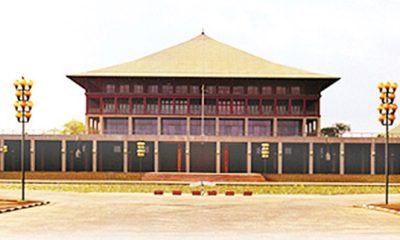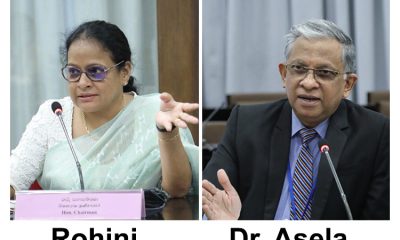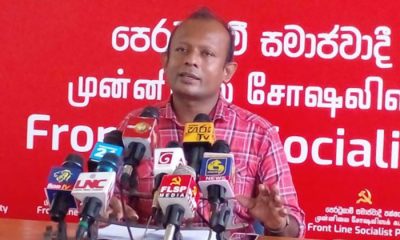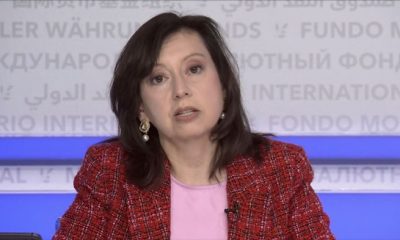Features
After May Day: Now What?

by Kumar David
The diagnostics and the prognostics after May Day are in. I discard the assertions of those who are committed to fixed opinions and repeat their convictions sans analysis. (“Everything is proof that the JVP/NPP is heading for a landslide victory”. “Only Ranil can deliver the goods and the people will rally around him”. “Sajith’s star is rising, he is our next president come what may”, etc). I have taken note only of intelligent people who have interpreted events and evidence with an analytical mind. For example, Mr X has access to several observers, police reports and what state officials and business leaders say and has sifted through all of this. Mr X may have political preferences of his own but he is “scientific” in interpreting evidence. This is the type of person I have given credence to in this piece.
The facts diligently extracted from such sources are as follows.
· The JVP/NPP rallies and meetings in Colombo and Matara were impressive, Anuradhapura was so-so and Jaffna was a failure.
· Ranil had the advantages of incumbency – streamlined train and bus services – but the showing was not impressive. Some who were expected, refrained from climbing on his stage The section below entitled Closing Arguments for the Novice is an important follow up this matter.
· Sajith’s show was, well ok, but not impressive enough; well, so-so again
· Mahinda’s SLPP was abysmal. People say the SLPP will be hard pressed to poll 10%.
· The SLFP showing was also poor; maybe 10% of the total poll.
Now let me move to the next set of questions. One that is often asked is “If it appears to Ranil that he is going to be hard pressed by Anura, is he likely to cancel the presidential election that by law must be held in about October this year”. My sharp and peremptory response is “No ways. He dare not try that lark! The country will explode and the international community will roundly condemn him. The preservation of democracy in Lanka is the bottom line that cannot be crossed: It will not sit comfortably with the West, the IMF, its Extended Fund Facility (EFF) or with India. Nor is there anything in it for China or conversely for global imperialism (meaning the US) either. The presidential election will be held!
If the presidential election is held as scheduled, what of the outcome? My informants like Mr X, separate from their own preferences, suggest that there is a fairly good chance that the JVP will prevail. Lots of people say “We have tried everything else and failed, might as well give the b…..ers a chance”. All of us have heard this and I am only repeating something familiar to most of you. Please believe me, though my own leftist leanings are familiar to many of you, this is not the motive for this avowal.
There is still the nagging concern “Can the 3% become 50%”? The JVP always showcased enormous rallies but come elections it rarely polled more than about 3%! Could this time also be another flash in the pan? Too early to tell but the trends will become clear in the coming months. Let’s watch.
My comment about democracy in Sri Lanka has another side to it. Nearly all of the moral pariahs who voted to turn this country into a dictatorship, that is nearly ALL who voted for a constitutional amendment permitting Mahinda a third term (and thereafter unlimited terms thus making the country another Idi Amin, Papa Doc state) are still sitting in the Chamber. They are worse than harlots since the ladies of the night have hungry children to feed or sick relatives to minister to. Our parliamentary pariahs were only fattening themselves or seeking renomination from Mahinda. Among them is Vasu – I confess I made the mistake of briefly joining a political faction led by him. Attorney Lal Wijeyanayake and Prof. Vijaya Kumar, also leftists like me, did not make that mistake. Ceylon/SL parliament’s finest constitutionalist may have had hopes of nurturing Vasu as a future member of the leadership team. NM would be turning in his grave but he was cremated and spared that indignity.
Whosoever is elected president and forms the next government is certain to dissolve parliament and attempt to secure a working parliamentary majority at a fresh parliamentary election. He (no she in sight) will face monumental tasks. SL faces colossal challenges in attempting to dig itself out of the pit it fell into in 2021-22, namely default on international debt, downgrading by international rating agencies, conflict with Sovereign Bond holders (that is capitalist market agencies who want all their money back, and don’t want to suffer a hair-cut) and other complex and painful economic choices.
The four big challenges facing Lanka in order are as follows:
· Paying off a sufficient part of the country’s accumulated debt to satisfy the IMF and its Extended Fund Facility that the economy is in repair and that some part of the over $5 billion of currently blocked IMF funds can be released. The IMF Board is unlikely to play hangman and push Lanka into anarchy if there is proof of seriousness of purpose. And which is more difficult, if serious steps are taken to fight political corruption, leniency can be expected.
· Strengthening the export orientation of the economy because economic consolidation is critically dependent on the performance of exports.
· Persuading the people to accept a degree of belt-tightening; difficult in the light of widespread poverty (about a quarter of the population lives below the official poverty line). But people will be prepared to go with it if they are convinced that the burden is being equitably shared and this not a gimmick by the well-to-do to retain their privileges and pass the buck. There are dozens of commentators in the centre pages of our newspapers who are buck-passers, that is apologists for assemblies like the Official Creditor Committee (OCC).
· Persuading the Left that an all-populist all-socialist agenda is not on the cards, anywhere, at this stage in world history.
In respect of the last point a significant matter has come to my attention. The NPP is not bereft of wise and mature advisors, as people had feared. It seems that there are informed economists and sombre advisors even on delicate topics like national security, working with the NPP. This is no longer the ludicrous Wijeweera JVP era; it is more sombre. Nevertheless, the May Day declaration by Lal Kantha (the JVP’s foremost buffalo and trade union leader) that an NPP government will devolve and vest judicial power in its own grass-roots bodies and Harini’s acute embarrassment in Parliament to try to wriggle out, will worry people about repetition of Rohana era escapades. This is going to cost the NPP some votes.
Of Lanka’s national debt of $ 58 billion, $ 27 billion is owed to bilateral and commercial creditors. Hence, even after debt restructuring a largish burden still remains and arrears and installments have to be serviced. Usable foreign reserves of the Central Bank are only $ 3.4 billion. Since my readers, like myself, are probably novices in economic jargon let me sign off with a summary of some terminology.
Closing Arguments for the novice
The Government and the State are different though they overlap and sometimes collide. Government is the Prime Minister, Cabinet Ministers, their immediate staff and to a degree Parliament which votes money for the Government (the Budget). The main sources of Government revenue are taxes, customs duties and excise duties and its main expenses are social-services like health, education, welfare-subsidies and development programmes. Ideally the budget should balance but rarely, in Lanka or anywhere else does it. Invariably the Budget is in deficit and this is what this Closing Argument is about.
For the sake of this section of the essay, only, I will define the State as the Central Bank (CB). Of course it is much more, the judiciary, the bureaucracy in general and the military. But let me move on with my point. The CB is broadly responsible for the nation’s finances; printing money, managing rupee exchange rates and interest rates, managing inflation, monitoring foreign asset movements, issuing Treasury Bills and doing the sort of things foreign lenders, bond holders, and the IMF are much concerned about.
Yes, there is constant bickering with Government and much interference in every country – you name it. But the big point I am making is that though the CB is responsible for the nation’s external finances, in the case of Lanka, the President and the Governor of the CB are singing the same arpeggio. Ranil says my government is doing all the right things and Nandalal Weerasinghe (NW) says ‘we are on the right track, let’s go on as we are’. Ranil says “the rupee has strengthened above LKR 300 to the dollar, we have brought total debt from about 128% of GDP to below 100%, analysts say GDP growth in 2024 will exceed 3% and foreign reserves are improving”. All this seems to be music to NW’s ears. However, since we have got it wrong so often in the past, nobody is as yet offering any bets.
Features
The heart-friendly health minister

by Dr Gotabhya Ranasinghe
Senior Consultant Cardiologist
National Hospital Sri Lanka
When we sought a meeting with Hon Dr. Ramesh Pathirana, Minister of Health, he graciously cleared his busy schedule to accommodate us. Renowned for his attentive listening and deep understanding, Minister Pathirana is dedicated to advancing the health sector. His openness and transparency exemplify the qualities of an exemplary politician and minister.
Dr. Palitha Mahipala, the current Health Secretary, demonstrates both commendable enthusiasm and unwavering support. This combination of attributes makes him a highly compatible colleague for the esteemed Minister of Health.
Our discussion centered on a project that has been in the works for the past 30 years, one that no other minister had managed to advance.
Minister Pathirana, however, recognized the project’s significance and its potential to revolutionize care for heart patients.
The project involves the construction of a state-of-the-art facility at the premises of the National Hospital Colombo. The project’s location within the premises of the National Hospital underscores its importance and relevance to the healthcare infrastructure of the nation.
This facility will include a cardiology building and a tertiary care center, equipped with the latest technology to handle and treat all types of heart-related conditions and surgeries.
Securing funding was a major milestone for this initiative. Minister Pathirana successfully obtained approval for a $40 billion loan from the Asian Development Bank. With the funding in place, the foundation stone is scheduled to be laid in September this year, and construction will begin in January 2025.
This project guarantees a consistent and uninterrupted supply of stents and related medications for heart patients. As a result, patients will have timely access to essential medical supplies during their treatment and recovery. By securing these critical resources, the project aims to enhance patient outcomes, minimize treatment delays, and maintain the highest standards of cardiac care.
Upon its fruition, this monumental building will serve as a beacon of hope and healing, symbolizing the unwavering dedication to improving patient outcomes and fostering a healthier society.We anticipate a future marked by significant progress and positive outcomes in Sri Lanka’s cardiovascular treatment landscape within the foreseeable timeframe.
Features
A LOVING TRIBUTE TO JESUIT FR. ALOYSIUS PIERIS ON HIS 90th BIRTHDAY

by Fr. Emmanuel Fernando, OMI
Jesuit Fr. Aloysius Pieris (affectionately called Fr. Aloy) celebrated his 90th birthday on April 9, 2024 and I, as the editor of our Oblate Journal, THE MISSIONARY OBLATE had gone to press by that time. Immediately I decided to publish an article, appreciating the untiring selfless services he continues to offer for inter-Faith dialogue, the renewal of the Catholic Church, his concern for the poor and the suffering Sri Lankan masses and to me, the present writer.
It was in 1988, when I was appointed Director of the Oblate Scholastics at Ampitiya by the then Oblate Provincial Fr. Anselm Silva, that I came to know Fr. Aloy more closely. Knowing well his expertise in matters spiritual, theological, Indological and pastoral, and with the collaborative spirit of my companion-formators, our Oblate Scholastics were sent to Tulana, the Research and Encounter Centre, Kelaniya, of which he is the Founder-Director, for ‘exposure-programmes’ on matters spiritual, biblical, theological and pastoral. Some of these dimensions according to my view and that of my companion-formators, were not available at the National Seminary, Ampitiya.
Ever since that time, our Oblate formators/ accompaniers at the Oblate Scholasticate, Ampitiya , have continued to send our Oblate Scholastics to Tulana Centre for deepening their insights and convictions regarding matters needed to serve the people in today’s context. Fr. Aloy also had tried very enthusiastically with the Oblate team headed by Frs. Oswald Firth and Clement Waidyasekara to begin a Theologate, directed by the Religious Congregations in Sri Lanka, for the contextual formation/ accompaniment of their members. It should very well be a desired goal of the Leaders / Provincials of the Religious Congregations.
Besides being a formator/accompanier at the Oblate Scholasticate, I was entrusted also with the task of editing and publishing our Oblate journal, ‘The Missionary Oblate’. To maintain the quality of the journal I continue to depend on Fr. Aloy for his thought-provoking and stimulating articles on Biblical Spirituality, Biblical Theology and Ecclesiology. I am very grateful to him for his generous assistance. Of late, his writings on renewal of the Church, initiated by Pope St. John XX111 and continued by Pope Francis through the Synodal path, published in our Oblate journal, enable our readers to focus their attention also on the needed renewal in the Catholic Church in Sri Lanka. Fr. Aloy appreciated very much the Synodal path adopted by the Jesuit Pope Francis for the renewal of the Church, rooted very much on prayerful discernment. In my Religious and presbyteral life, Fr.Aloy continues to be my spiritual animator / guide and ongoing formator / acccompanier.
Fr. Aloysius Pieris, BA Hons (Lond), LPh (SHC, India), STL (PFT, Naples), PhD (SLU/VC), ThD (Tilburg), D.Ltt (KU), has been one of the eminent Asian theologians well recognized internationally and one who has lectured and held visiting chairs in many universities both in the West and in the East. Many members of Religious Congregations from Asian countries have benefited from his lectures and guidance in the East Asian Pastoral Institute (EAPI) in Manila, Philippines. He had been a Theologian consulted by the Federation of Asian Bishops’ Conferences for many years. During his professorship at the Gregorian University in Rome, he was called to be a member of a special group of advisers on other religions consulted by Pope Paul VI.
Fr. Aloy is the author of more than 30 books and well over 500 Research Papers. Some of his books and articles have been translated and published in several countries. Among those books, one can find the following: 1) The Genesis of an Asian Theology of Liberation (An Autobiographical Excursus on the Art of Theologising in Asia, 2) An Asian Theology of Liberation, 3) Providential Timeliness of Vatican 11 (a long-overdue halt to a scandalous millennium, 4) Give Vatican 11 a chance, 5) Leadership in the Church, 6) Relishing our faith in working for justice (Themes for study and discussion), 7) A Message meant mainly, not exclusively for Jesuits (Background information necessary for helping Francis renew the Church), 8) Lent in Lanka (Reflections and Resolutions, 9) Love meets wisdom (A Christian Experience of Buddhism, 10) Fire and Water 11) God’s Reign for God’s poor, 12) Our Unhiddden Agenda (How we Jesuits work, pray and form our men). He is also the Editor of two journals, Vagdevi, Journal of Religious Reflection and Dialogue, New Series.
Fr. Aloy has a BA in Pali and Sanskrit from the University of London and a Ph.D in Buddhist Philosophy from the University of Sri Lankan, Vidyodaya Campus. On Nov. 23, 2019, he was awarded the prestigious honorary Doctorate of Literature (D.Litt) by the Chancellor of the University of Kelaniya, the Most Venerable Welamitiyawe Dharmakirthi Sri Kusala Dhamma Thera.
Fr. Aloy continues to be a promoter of Gospel values and virtues. Justice as a constitutive dimension of love and social concern for the downtrodden masses are very much noted in his life and work. He had very much appreciated the commitment of the late Fr. Joseph (Joe) Fernando, the National Director of the Social and Economic Centre (SEDEC) for the poor.
In Sri Lanka, a few religious Congregations – the Good Shepherd Sisters, the Christian Brothers, the Marist Brothers and the Oblates – have invited him to animate their members especially during their Provincial Congresses, Chapters and International Conferences. The mainline Christian Churches also have sought his advice and followed his seminars. I, for one, regret very much, that the Sri Lankan authorities of the Catholic Church –today’s Hierarchy—- have not sought Fr.
Aloy’s expertise for the renewal of the Catholic Church in Sri Lanka and thus have not benefited from the immense store of wisdom and insight that he can offer to our local Church while the Sri Lankan bishops who governed the Catholic church in the immediate aftermath of the Second Vatican Council (Edmund Fernando OMI, Anthony de Saram, Leo Nanayakkara OSB, Frank Marcus Fernando, Paul Perera,) visited him and consulted him on many matters. Among the Tamil Bishops, Bishop Rayappu Joseph was keeping close contact with him and Bishop J. Deogupillai hosted him and his team visiting him after the horrible Black July massacre of Tamils.
Features
A fairy tale, success or debacle

Sri Lanka-Singapore Free Trade Agreement
By Gomi Senadhira
senadhiragomi@gmail.com
“You might tell fairy tales, but the progress of a country cannot be achieved through such narratives. A country cannot be developed by making false promises. The country moved backward because of the electoral promises made by political parties throughout time. We have witnessed that the ultimate result of this is the country becoming bankrupt. Unfortunately, many segments of the population have not come to realize this yet.” – President Ranil Wickremesinghe, 2024 Budget speech
Any Sri Lankan would agree with the above words of President Wickremesinghe on the false promises our politicians and officials make and the fairy tales they narrate which bankrupted this country. So, to understand this, let’s look at one such fairy tale with lots of false promises; Ranil Wickremesinghe’s greatest achievement in the area of international trade and investment promotion during the Yahapalana period, Sri Lanka-Singapore Free Trade Agreement (SLSFTA).
It is appropriate and timely to do it now as Finance Minister Wickremesinghe has just presented to parliament a bill on the National Policy on Economic Transformation which includes the establishment of an Office for International Trade and the Sri Lanka Institute of Economics and International Trade.
Was SLSFTA a “Cleverly negotiated Free Trade Agreement” as stated by the (former) Minister of Development Strategies and International Trade Malik Samarawickrama during the Parliamentary Debate on the SLSFTA in July 2018, or a colossal blunder covered up with lies, false promises, and fairy tales? After SLSFTA was signed there were a number of fairy tales published on this agreement by the Ministry of Development Strategies and International, Institute of Policy Studies, and others.
However, for this article, I would like to limit my comments to the speech by Minister Samarawickrama during the Parliamentary Debate, and the two most important areas in the agreement which were covered up with lies, fairy tales, and false promises, namely: revenue loss for Sri Lanka and Investment from Singapore. On the other important area, “Waste products dumping” I do not want to comment here as I have written extensively on the issue.
1. The revenue loss
During the Parliamentary Debate in July 2018, Minister Samarawickrama stated “…. let me reiterate that this FTA with Singapore has been very cleverly negotiated by us…. The liberalisation programme under this FTA has been carefully designed to have the least impact on domestic industry and revenue collection. We have included all revenue sensitive items in the negative list of items which will not be subject to removal of tariff. Therefore, 97.8% revenue from Customs duty is protected. Our tariff liberalisation will take place over a period of 12-15 years! In fact, the revenue earned through tariffs on goods imported from Singapore last year was Rs. 35 billion.
The revenue loss for over the next 15 years due to the FTA is only Rs. 733 million– which when annualised, on average, is just Rs. 51 million. That is just 0.14% per year! So anyone who claims the Singapore FTA causes revenue loss to the Government cannot do basic arithmetic! Mr. Speaker, in conclusion, I call on my fellow members of this House – don’t mislead the public with baseless criticism that is not grounded in facts. Don’t look at petty politics and use these issues for your own political survival.”
I was surprised to read the minister’s speech because an article published in January 2018 in “The Straits Times“, based on information released by the Singaporean Negotiators stated, “…. With the FTA, tariff savings for Singapore exports are estimated to hit $10 million annually“.
As the annual tariff savings (that is the revenue loss for Sri Lanka) calculated by the Singaporean Negotiators, Singaporean $ 10 million (Sri Lankan rupees 1,200 million in 2018) was way above the rupees’ 733 million revenue loss for 15 years estimated by the Sri Lankan negotiators, it was clear to any observer that one of the parties to the agreement had not done the basic arithmetic!
Six years later, according to a report published by “The Morning” newspaper, speaking at the Committee on Public Finance (COPF) on 7th May 2024, Mr Samarawickrama’s chief trade negotiator K.J. Weerasinghehad had admitted “…. that forecasted revenue loss for the Government of Sri Lanka through the Singapore FTA is Rs. 450 million in 2023 and Rs. 1.3 billion in 2024.”
If these numbers are correct, as tariff liberalisation under the SLSFTA has just started, we will pass Rs 2 billion very soon. Then, the question is how Sri Lanka’s trade negotiators made such a colossal blunder. Didn’t they do their basic arithmetic? If they didn’t know how to do basic arithmetic they should have at least done their basic readings. For example, the headline of the article published in The Straits Times in January 2018 was “Singapore, Sri Lanka sign FTA, annual savings of $10m expected”.
Anyway, as Sri Lanka’s chief negotiator reiterated at the COPF meeting that “…. since 99% of the tariffs in Singapore have zero rates of duty, Sri Lanka has agreed on 80% tariff liberalisation over a period of 15 years while expecting Singapore investments to address the imbalance in trade,” let’s turn towards investment.
Investment from Singapore
In July 2018, speaking during the Parliamentary Debate on the FTA this is what Minister Malik Samarawickrama stated on investment from Singapore, “Already, thanks to this FTA, in just the past two-and-a-half months since the agreement came into effect we have received a proposal from Singapore for investment amounting to $ 14.8 billion in an oil refinery for export of petroleum products. In addition, we have proposals for a steel manufacturing plant for exports ($ 1 billion investment), flour milling plant ($ 50 million), sugar refinery ($ 200 million). This adds up to more than $ 16.05 billion in the pipeline on these projects alone.
And all of these projects will create thousands of more jobs for our people. In principle approval has already been granted by the BOI and the investors are awaiting the release of land the environmental approvals to commence the project.
I request the Opposition and those with vested interests to change their narrow-minded thinking and join us to develop our country. We must always look at what is best for the whole community, not just the few who may oppose. We owe it to our people to courageously take decisions that will change their lives for the better.”
According to the media report I quoted earlier, speaking at the Committee on Public Finance (COPF) Chief Negotiator Weerasinghe has admitted that Sri Lanka was not happy with overall Singapore investments that have come in the past few years in return for the trade liberalisation under the Singapore-Sri Lanka Free Trade Agreement. He has added that between 2021 and 2023 the total investment from Singapore had been around $162 million!
What happened to those projects worth $16 billion negotiated, thanks to the SLSFTA, in just the two-and-a-half months after the agreement came into effect and approved by the BOI? I do not know about the steel manufacturing plant for exports ($ 1 billion investment), flour milling plant ($ 50 million) and sugar refinery ($ 200 million).
However, story of the multibillion-dollar investment in the Petroleum Refinery unfolded in a manner that would qualify it as the best fairy tale with false promises presented by our politicians and the officials, prior to 2019 elections.
Though many Sri Lankans got to know, through the media which repeatedly highlighted a plethora of issues surrounding the project and the questionable credentials of the Singaporean investor, the construction work on the Mirrijiwela Oil Refinery along with the cement factory began on the24th of March 2019 with a bang and Minister Ranil Wickremesinghe and his ministers along with the foreign and local dignitaries laid the foundation stones.
That was few months before the 2019 Presidential elections. Inaugurating the construction work Prime Minister Ranil Wickremesinghe said the projects will create thousands of job opportunities in the area and surrounding districts.
The oil refinery, which was to be built over 200 acres of land, with the capacity to refine 200,000 barrels of crude oil per day, was to generate US$7 billion of exports and create 1,500 direct and 3,000 indirect jobs. The construction of the refinery was to be completed in 44 months. Four years later, in August 2023 the Cabinet of Ministers approved the proposal presented by President Ranil Wickremesinghe to cancel the agreement with the investors of the refinery as the project has not been implemented! Can they explain to the country how much money was wasted to produce that fairy tale?
It is obvious that the President, ministers, and officials had made huge blunders and had deliberately misled the public and the parliament on the revenue loss and potential investment from SLSFTA with fairy tales and false promises.
As the president himself said, a country cannot be developed by making false promises or with fairy tales and these false promises and fairy tales had bankrupted the country. “Unfortunately, many segments of the population have not come to realize this yet”.
(The writer, a specialist and an activist on trade and development issues . )













